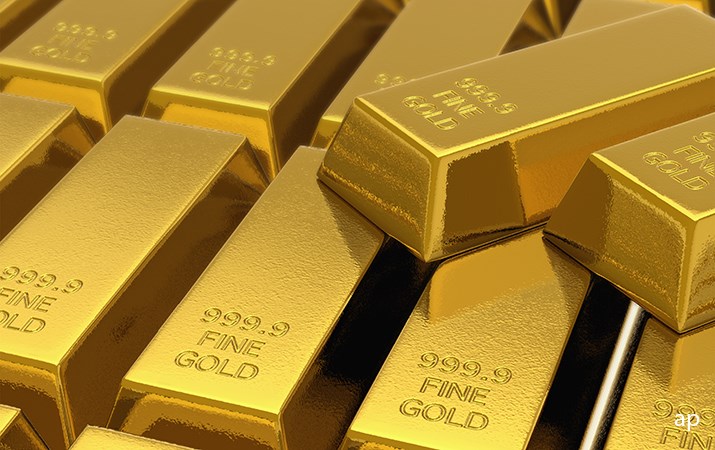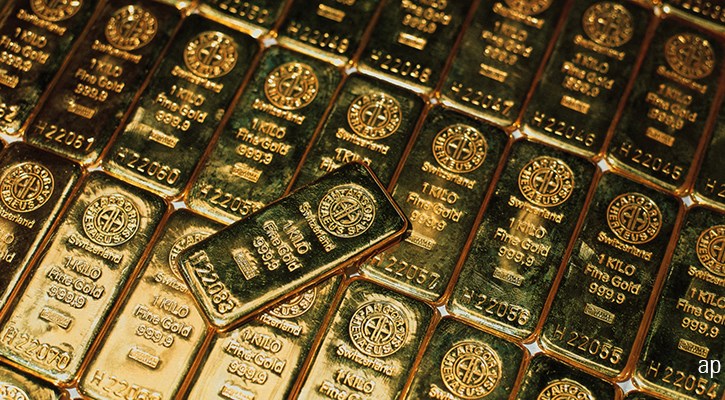
Gold has hit a record high this week as the coronavirus panic has sent investors scrambling for the traditional safe haven while stock markets plunge.
The price of gold in sterling is now around £1,279 per ounce, having broken through £1,300 early this week, a new high for the yellow metal. The Royal Mint says it has seen a near five-fold increase in demand for gold bars and coins in just a week.
Gold also reached a seven-year high in dollar terms, as it passed through $1,600. This is not a record, however, as the yellow metal reached nearly $1,900 in 2011 during a bull run for the precious metal following the financial crisis.
Since 2011, the pound has weakened against the dollar and this explains part of the reason why gold is at a record high in sterling terms but not in dollars. To buy an ounce of gold at its $1,900 peak in 2011 cost you £1,187 and now that would cost you £1,303.
Global stock markets have plunged in the past few days as the risks of Covid-19 becoming a worldwide pandemic have risen – the Dow Jones is off around 2,000 points this week alone – even though Chinese stocks started reacted to the threat more than a month ago.
But gold’s upward run predates the coronavirus outbreak, with a number of factors working in favour of a price increase last year, including a weaker dollar, Middle East tensions, the US/China trade war and loose monetary policy. Morningstar analyst Kristoffer Inton says that looking at data over the past 20 years, the gold price and the S&P 500 have moved in opposite direction – a trend that should be sustainable in the long run, he argues.
Gold Up, Shares Up
The traditional “shares down/gold up” pattern has been tested in recent years: gold and bond prices have gone up, reflecting investor anxiety about the future, as global stock market have surged to new record highs. It's worth pointing out, however, that while gold may offer investors some form of reassurance as a “store of value” if the economic system collapses, but owning gold indirectly (as many investors do via ETFs) will be of little practical use if this happens.
Chris Mahoney, portfolio manager on the Merian Gold & Silver fund, says that both high stock markets and rising gold prices make sense in a world of ultra-low interest rates: investors are not getting a decent income buying the usual safe-haven assets such as bonds so are happier to buy non-income producing assets such as gold. The lack of a income from bonds is also driving up demand for shares, which pushes prices ever higher. So you can have a bull run in safe-haven and risky assets at the time under this scenario.
He also thinks many people buying are buying gold because the price is going up - what is known as "momentum investing" - and that is likely to continue this year.
With gold only 15% off its all-time high in 2011 in dollar terms, Mahoney argues that the precious metal could beat that level this year. Central bank buying of physical gold has been on the increase too, and this could further support the gold price this year, he argues.
2019 a Great Year for Gold Funds
Investors in gold funds have been well rewarded in the past year: Bronze-rated BlackRock Gold and General posted a gain of 32.5% in 2019 and the Merian fund rose 36.6%, both beating one of the best-performing world indices, the S&P 500, which was 30% higher in 2019.
Robin Newbould, managing director of BullionRock, argues that gold’s price rise has been helped by the coronavirus outbreak but the recent bull run predates the recent panic. He believes that investors need to look beyond the current health panic and consider gold’s long-term ability to generate “positive, non-correlated returns that hold their own when compared to other assets”.
Many asset managers have been advising clients to increase their allocation to gold even while remaining optimistic about the world economy. In a recent 2020 outlook, Janet Mui, global economist at Cazenove Capital – which is owned by fund giant Schroders – flagged US-Iran tensions as a reason for clients to boost buy into gold even at elevated prices.
With the rise in crypto-currencies in recent years, many experts argued that Bitcoin would surpass gold as a safe haven in times of market distress. But so far the Bitcoin price, at $9,000, is 27% higher than at the start of the year, it’s still way off its 2017 peak of almost $20,000.




























